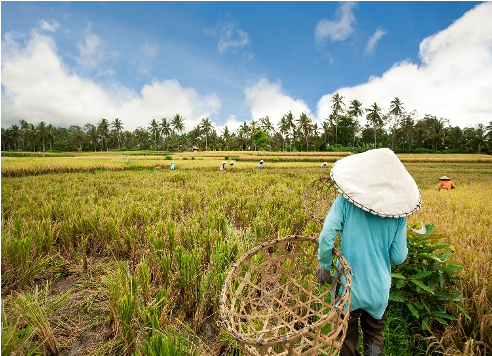If I could time travel: does access to credit help the decision to adapt to climate change in developing countries?
The evidence from a recent meta-analysis shows rather mixed results, pointing towards the need for better targeted financial instruments.
Humankind has long fantasized with the idea of time travel as a means to anticipate and deal with misfortune and opportunities. Although the laws of physics have struck a heavy blow to these aspirations, for centuries we have unknowingly had a (not so) secret weapon that allows us to bring a precious asset from the future into the present: credit.
Indeed, most financial instruments could be regarded as time machines for bills and coins, making it possible for us to enjoy the fruits of our future endeavors today, provided these efforts are targeted towards creating wealth and prosperity. And what best scenario to test the wonders of such a tool than the challenges and opportunities that climate change brings to our horizons? Tackling the already evident manifestations of climate change and its future implications require resources including technologies, infrastructure and skills, which are not always easily accessible and affordable. This is particularly true in the context of developing countries, where communities are commonly dependent on natural resources and farming. Adapting livelihoods and traditional productive processes is not only a matter of changing attitudes and switching rooted habits; it can also require a costly investment for households and small farmers who, being aware of the need to take action, would gladly activate that time travel mechanism to address current problems with the expectation about future prosperity.
For this reason, credit has long been claimed to be a powerful instrument to support action against climate change by farming households. Its role in the buildup of adaptive capacity has been the subject of many empirical studies that address, not only the effectiveness of credit, but also many other factors influencing the decision by households in the developing world to adapt their livelihoods. We look at the global evidence around this topic in our gap-map [1], which will be published soon by the IEU and DEval.
In our recent meta-analysis report [2] to be published by the IEU and DEval in the coming weeks, we analyze this evidence specifically, collected from 44 different research articles, to answer the question “Does access to credit truly influence the decision by households in developing countries to undertake action against the impacts of climate change?”
No matter how attractive the time-traveling money narrative may be, the evidence shown in the empirical literature has presented a more prosaic reality: well, it all depends. The research articles that made the cut for our meta-analysis all share a common feature, which is the inclusion of a comparison between farming households who enjoyed access to any form of credit, against those who did not. The target feature to be compared among these two groups is whether the group that uses credit is more likely to engage in any type of adaptation action (at the individual or community level). The exact analytical methods to draw conclusions, the different modalities of credit products, and the different adaptation strategies vary heavily across studies.
Despite the great disparity of approaches, a majority of studies (54% of total evidence) highlight an absence of a consensus conclusion: that is to say, the data do not provide enough evidence to support the idea that access to credit is associated with higher or lower propensity to adapt to climate change. Even more surprising is the fact that a non-negligible 13% of the total evidence found a negative effect of credit on the decision to adapt to climate change, meaning that the more is borrowed, the less action is taken. Nevertheless, for nearly one-third of the total evidence reviewed, our financial time machine mechanism seems to be an effective tool to enhance adaptive capacity. This inevitably leads us to the next unsolved mystery: why is there so much disparity and inconclusiveness among the evidence?
The most straightforward answer could be in principle found in the narrative provided by each of the individual research articles. The most useful studies in this regard are those in which inconclusive or negative effects were found because these are the counterintuitive cases. In these, some authors have suggested that farming households may prefer to (or need to) use credit for consumption goods, rather than for productive investments. The foundations of this micro-sociologic hypothesis escape the scope of our empirical evidence, but if confirmed, it may help us to make a case for better targeted financial instruments that can channel resources towards the reinforcement of adaptive capacity.
[1]Doswald, N., L. Sanchez Torrente, A. Reumann, G. Leppert, K. Moull, J.R. Pérez, A. Köngeter, G. Fernández de Velasco, S. Harten and J. Puri. (forthcoming, 2020). Evidence Gap and Intervention Heat Maps of Climate Change Adaptation in Low- and Middle-Income Countries. DEval Discussion Paper 3/2020, German Institute for Development Evaluation (DEval), Bonn, Germany. Independent Evaluation Unit, Green Climate Fund. Songdo, South Korea.
[2]Fernández de Velasco, G., G. Leppert, K. Moull, M. Prowse, J. Puri, A. Reumann and L. Sanchez Torrente (forthcoming, 2020), Access to credit as a determinant of autonomous adaptation to climate change: A meta-analysis of the evidence in low- and middle-income countries. DEval Discussion Paper 4/2020, German Institute for Development Evaluation (DEval), Bonn, Germany. Independent Evaluation Unit, Green Climate Fund. Songdo, South Korea.
Disclaimer: The views expressed in this guest blog are the author's own and do not necessarily reflect the views of the Independent Evaluation Unit of the Green Climate Fund.
